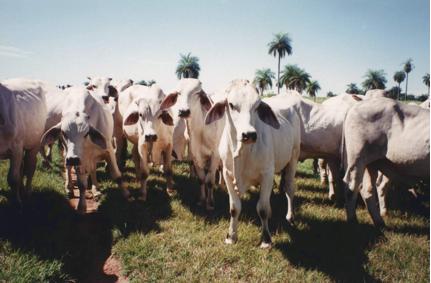The Economy in 3 Modes
By Ravindra Svarupa Dasa | Jun 20, 2009

“The Economy Is Still at the Brink,” warns Sandy Lewis and William Cohan in a full-page op-ed piece in the Sunday Times of June 7. With the coverage and mayhem of a shotgun blast, the authors let loose at the President’s remedial programs and advance their own remedies. Periodically the text balloons into sections of bold-faced, screaming, headline multi-sized fonts—the usual signal of a rant in progress. (A first for the staid and sober “paper of record?”) For example:
The tone of the piece, reminiscent of the Old Testament prophets, is notable; the inquisitive reader may savor the authors’ secular jeremiad in its entirety here. Sandy Lewis is himself a confessed and pardoned Wall Street sinner. Now he is an organic farmer (“grass-fed beef” unfortunately included) in the Adirondacks. His co-author William Cohan, a seventeen-year Wall-street veteran turned journalist, has offered the nation his tell-all account of gluttony at the Bear Stearns financial pig-trough in his narration of the foundering of that Titanic among investment banks, House of Cards: A Tale of Hubris and Wretched Excess on Wall Street. They have survived the shipwreck to tell us.
Of all the bullet-pointed proposals blasted at us, a short one struck me hardest:
Instead of promising the imminent return of good times, why isn’t Mr. Obama talking more about the importance of living within our means and not spending money we don’t have on things we don’t need? We used to be a frugal nation. The president should be talking about kicking our addictions to easy credit, to quick fixes and to a culture of more is better . . . .
Gas-guzzling S.U.V.’s, cigarette boats, no-income mortgages and private jets should be relegated to the junk heaps of history, or better yet, put in a museum dedicated to never forgetting the greed and avarice that led us so far astray.
Its opening question distinguished as a graphical howl, this proposal strikes me as the most fundamental of all, as the most necessary, as the most radical, and for those reasons the most nearly impossible: Forswearing “greed and avarice”? Kicking our addiction to “a culture of more is better”?
These undertakings would uproot the very foundation of our American way of life; they demand a profound change of culture, of individual lifestyle and outlook.
Yet it is just this sort of remedial cultural transformation that Prabhupāda hoped to bring about in the world through his offerings of Bhagavad-gītā and Śrīmad Bhāgavatam, calling the latter “a cultural presentation for the respiritualization of the entire human society.”
THE STORM indeed is a long way from over, yet so far as I can tell neither the traumatized survivors of Wall Street nor the President understand how to effect the necessary changes—change you really can believe in.
To anyone committed to bringing about a transformation in the iniquitous ways of this world’s misdirected civilization I recommend an ancient system as guide for this undertaking. The system is a science, containing, like any science, both theory and practice. By theory I mean an organized set of categories that illuminate the workings of the world, and by practice I mean the application of the theory to the world so as to bring about desired changes. Through science we can both understand how things are working and use our understanding to predict and control the course of events.
The scientific knowledge I’m concerned with has been developed in India among followers of the Vedas, and it is basic enough to be common to nearly all the various traditions of knowledge (vidyā) and application (yoga).
A concise and accessible exposition of this science can be found in the fourteenth chapter of the Bhagavad-gītā, which concerns itself with the “three modes of material nature” (guṇa traya), distinguishing each category from the others and the triad of guṇas from the state of transcendence (nir–guṇa).
Over the ages, the human race has embraced an extraordinary diversity of systems of thought. As social beings, we absorb a cultural world-view practically with our mother’s milk, and as we mature that view is enriched by friends and relatives, by teachers and other guides. We look at the world around us through the lenses so provided.
It has been said that every “seeing” is really a “seeing as,” that our perceptions of the world come to us to a degree already processed and interpreted, pre-consciously shaped by our biological, social, and historically conditioned mind and senses.
If you spend time studying philosophies and ideologies—as I did once—you’ll find that each makes it possible to comprehend reality as a unified, intelligible whole, and eventually you will be able to mentally browse through a succession of realities as comprehended, say, by Plato, Aristotle, Aquinas, and Spinoza, by Hegel, Marx, and Whitehead, and so on. In a sense, each of these systematic thinkers lives in a different world. Or each one lights up the given world—the inaccessible “thing-in-itself”?—in a certain idiosyncratic way, a way that may turn out to be quite satisfying or fruitful for some purpose or other. And each leaves parts in shadows, too: ignored or unexplained.
When I began to absorb the teachings of the Bhagavad-gītā and Śrīmad Bhāgavatam and viewed the world through their categories of thought, the world became illuminated in a new, fascinating, and extremely useful way. Not only did my study transform the way I saw the world: it transformed me. Bhagavad-gītā calls this phenomenon jñāna cakṣuṣaḥ, becoming endowed with eyes of knowledge.
An important element of that knowledge is seeing nature (prakṛti) working according to three guṇas.
The dictionary’s first definition of guṇa is “cord” or “strand.” Think of prakṛti as a rope made of three cords (guṇas) plaited or twisted together. As one of the constituent features of nature, guṇa denotes a “quality” or “attribute” of prakṛti, a way or manner in which it acts. Accordingly, Prabhupāda consistently translates guṇa by the English word “mode.”
All of us experience nature acting in three ways or modes—there’s nothing esoteric about this. Nature moves in repeating cycles made of three phases: creation, maintenance, and destruction. Whenever entities are being created, procreated, or constructed, nature is said to be acting in the mode of passion, rajo–guṇa. When entities are being maintained, conserved, or preserved, nature is acting in the mode of goodness or purity, sattva–guṇa. And when beings undergo deterioration, decay, or destruction, nature’s mode of ignorance or darkness, tamo–guṇa, is at work.
Entities come into being, endure for a time, and finally deteriorate and break down into their constituent parts. The end products of destruction are then taken up as raw materials to be assembled in the next cycle beginning with rajo–guṇa. Such cycles continue perpetually, from the microcosmic to the macrocosmic levels.
In the Vedic world-view, this cycle is one of many manifestations of the three guṇas at work, for the three guṇas constitute the universal defining categories for all productions of nature. For example, the devas, or demigods, are as a group situated in sattva–guṇa; the human species in rajo–guṇa; the animal, tamo–guṇa. And then those groups are further subdivided according to the guṇas. Among animals, for example, the cow is said to be in sattva–guṇa; the lion, rajo–guṇa; the monkey, tamo–guṇa.
Or consider dwelling places: Prabhupāda writes (SB 4.12.29, purport): “It is said, therefore, that to live in the forest is in the mode of goodness, to live in the city is in the mode of passion, and to live in a brothel, liquor shop or slaughterhouse is in the mode of ignorance.” You can see the point:
Similarly, diversity among humans is also produced by the guṇas, and the Gītā describes the resultant symptoms of each.
Sattva is considered the best and purest of the modes. In fact, the spiritual realm, above the material guṇas, is characterized as śuddha–sattva or viśuddha–sattva—pristine or pure goodness. There sattva is free even of the slightest tinge of passion and ignorance: All is in everlasting existence, and nothing comes to be or ceases to be. However, when sattva becomes manifest within material nature, it becomes braided together with rajas and tamas, so that sattva–guṇa is never found without at least a taint rajas and tamas.
Like the other guṇas, sattva too binds the soul to matter. Because of its purity, it is illuminating and immaculate. Yet a person in sattva guṇa becomes bound—by attachment to happiness and knowledge.
Rajas is manifest by passion—especially sexual—and it is born out of lust and other sensory urges and drives. A person under the sway of rajo–guṇa becomes driven by compulsions to action.
Tamas, born of ignorance, cause the delusion of all beings. A person in tamo–guṇa becomes fettered by bewilderment, apathy, indolence, and sleep. He becomes attached to the befuddlement by intoxication and to the oblivion offered by sleep, drugs, or fantasy life.
When sattva is dominant, the senses become pure receptacles of knowledge. Attention is highly alert and inquisitive, yet detached and disinterested.
The prominence of passion is evinced by unslakeable greed and hankerings, by restlessness, and by an obsession with “getting things done” and the undertaking of many projects. Attention in this mode becomes narrow and excited, focused on the objects of desire.
The dominance of tamas is seen in a person who becomes indifferent to knowledge; avoids activity; neglects caring for himself, others, and his surroundings; and even shows clinical signs of mental disorders. In tamo–guṇa attention tends to be attenuated, flickering, or misplaced.
In addition, the Gītā tells us that work (karma) done in each mode gives rise to a particular fruit or result (phalam): the good works done in sattva–guṇa produce pure and immaculate results; the product of work in raja–guṇa is suffering (duḥkham), and tamas engenders stupidity.
Summarizing, Prabhupāda writes: “The living entities conditioned by material nature are of various types. One is happy, another is very active, and another is helpless.”
Once I was granted a vision, a revelation of Prabhupāda’s words. It happened early one summer morning as I stepped out the front door of our Boston temple, a brownstone on Commonwealth Ave., a block and a half from the Public Garden. The two traffic lanes of the avenue sandwich a broad park-like meridian or mall, complete with shade trees, grass, and a wide walkway generously supplied with benches and civic statuary. I looked down from the temple entrance, across the inbound lanes, and into the mall and saw a living allegory enacted before my very eyes.
On the near edge of the walkway stood a young temple devotee, in robes of pale fire, absorbed in chanting on his beads. Moving on the pavement behind him, a nicely tonsured corporate go-getter in running shorts rushed by on slapping Nikes toward the Public Garden, Walkman wire swinging from his ear; and behind both figures a hirsute face rose up in annoyance from one end of a heap of filthy rags ranged upon a bench that sheltered several bottles flung upon the grass, each swaddled in the iconic paper bag. I saw it in a single glance! Sattva. Rajas. Tamas. The Epiphany of the Modes. If only my eye had been a camera!
Most of you will have recognized these three personality types, each with its particular constellations of characteristics, from your own experience (although it’s rare these days to encounter a person in the mode of goodness). You probably can also remember critical times in your own or another’s life in which a predominating mode was supplanted by another. The Gītā recognizes such alterations (14.10).
Indeed, we’re not only familiar with such upheavals ourselves; we’re fascinated by them. Consider the public’s insatiable appetite for true-life narrations about people (preferably famous) who dramatically undergo alterations in dominant modes. We’re all well acquainted with the basic plot: The hero, from hard-scrabble origins in tamo–guṇa, rises by talent, luck, and labor to rajo–guṇa, only to suffer a horrifying plummet and deeper re-immersion in tamo–guṇa; then, impelled by the near miraculous intervention of an agent who personifies sattva–guṇa, the protagonist undertakes an agonizing, prolonged, and suspenseful struggle to eventually triumph by regaining rajo–guṇa, leavened this time with a dollop of sattva.
It is clear that phenomena dealt with by the science of guṇa–traya are not only familiar to us but important as well. The science teaches us how to see: it provides us categories that elucidate our experiences, guide and inform our perceptions. Offering a clear and coherent insight into the workings of the modes, it empowers us to deal with them effectively. Before, we had been travelers making our way blindly through an unfamiliar land. Now we have a map.
























